Citroen C3 RHD 2015 2.G Owner's Manual
Manufacturer: CITROEN, Model Year: 2015, Model line: C3 RHD, Model: Citroen C3 RHD 2015 2.GPages: 324, PDF Size: 9.86 MB
Page 201 of 324
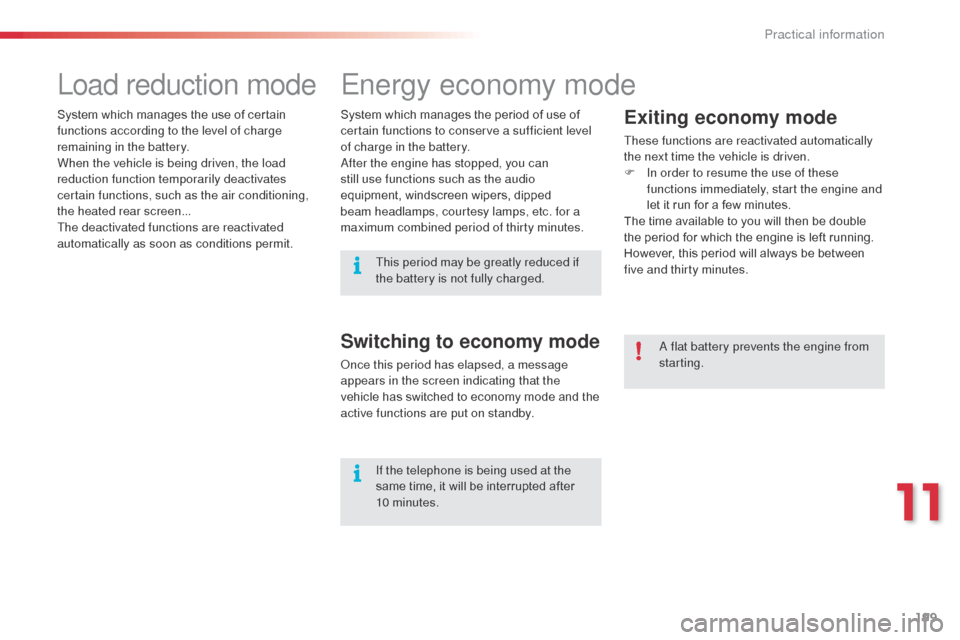
199
Energy economy mode
Exiting economy mode
These functions are reactivated automatically
the next time the vehicle is driven.
F
I
n order to resume the use of these
functions immediately, start the engine and
let it run for a few minutes.
The time available to you will then be double
the period for which the engine is left running.
However, this period will always be between
five and thirty minutes.
Switching to economy mode
once this period has elapsed, a message
appears in the screen indicating that the
vehicle has switched to economy mode and the
active functions are put on standby.
a
flat battery prevents the engine from
starting.
If the telephone is being used at the
same time, it will be interrupted after
10 minutes.
System which manages the period of use of
certain functions to conserve a sufficient level
of charge in the battery.
af
ter the engine has stopped, you can
still use functions such as the audio
equipment, windscreen wipers, dipped
beam headlamps, courtesy lamps, etc. for a
maximum combined period of thirty minutes.
System which manages the use of certain
functions according to the level of charge
remaining in the battery.
When the vehicle is being driven, the load
reduction function temporarily deactivates
certain functions, such as the air conditioning,
the heated rear screen...
The deactivated functions are reactivated
automatically as soon as conditions permit.
Load reduction mode
This period may be greatly reduced if
the battery is not fully charged.
11
Practical information
Page 202 of 324
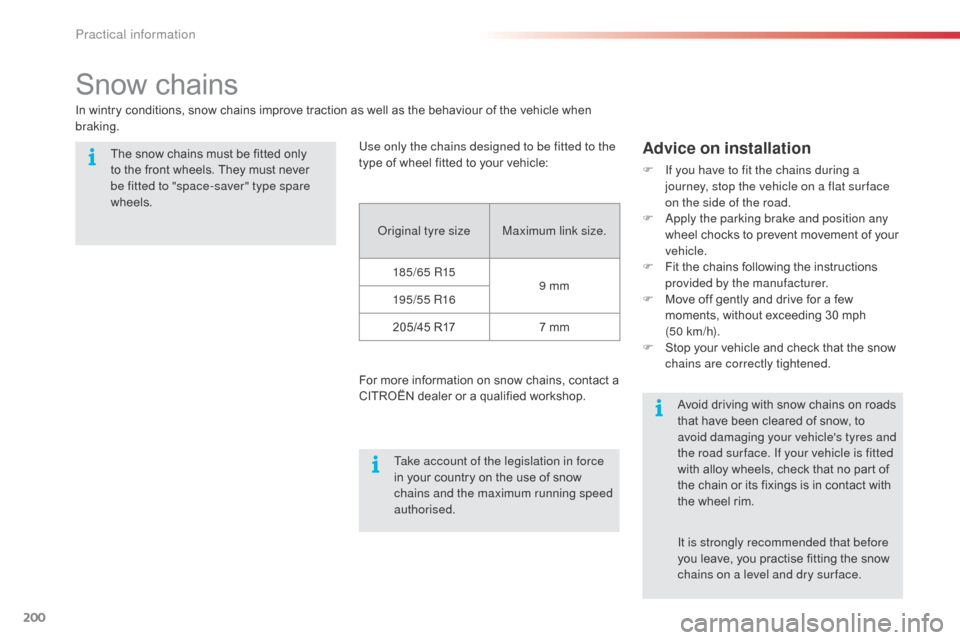
200
Snow chains
In wintry conditions, snow chains improve traction as well as the behaviour of the vehicle when
braking.The snow chains must be fitted only
to the front wheels. They must never
be fitted to "space-saver" type spare
wheels.
Take account of the legislation in force
in your country on the use of snow
chains and the maximum running speed
authorised.Avoid driving with snow chains on roads
that have been cleared of snow, to
avoid damaging your vehicle's tyres and
the road sur face. If your vehicle is fitted
with alloy wheels, check that no part of
the chain or its fixings is in contact with
the wheel rim.
Use only the chains designed to be fitted to the
type of wheel fitted to your vehicle:
or
iginal tyre sizeMaximum link size.
185/65 R15 9 mm
195/55 R16
205/45 R17 7 mm
For more information on snow chains, contact a
CITROËN dealer or a qualified workshop.
Advice on installation
F If you have to fit the chains during a journey, stop the vehicle on a flat sur face
on the side of the road.
F
a
p
ply the parking brake and position any
wheel chocks to prevent movement of your
vehicle.
F
F
it the chains following the instructions
provided by the manufacturer.
F
M
ove off gently and drive for a few
moments, without exceeding 30 mph
(50
km/h).
F
S
top your vehicle and check that the snow
chains are correctly tightened.
It is strongly recommended that before
you leave, you practise fitting the snow
chains on a level and dry sur face.
Practical information
Page 203 of 324
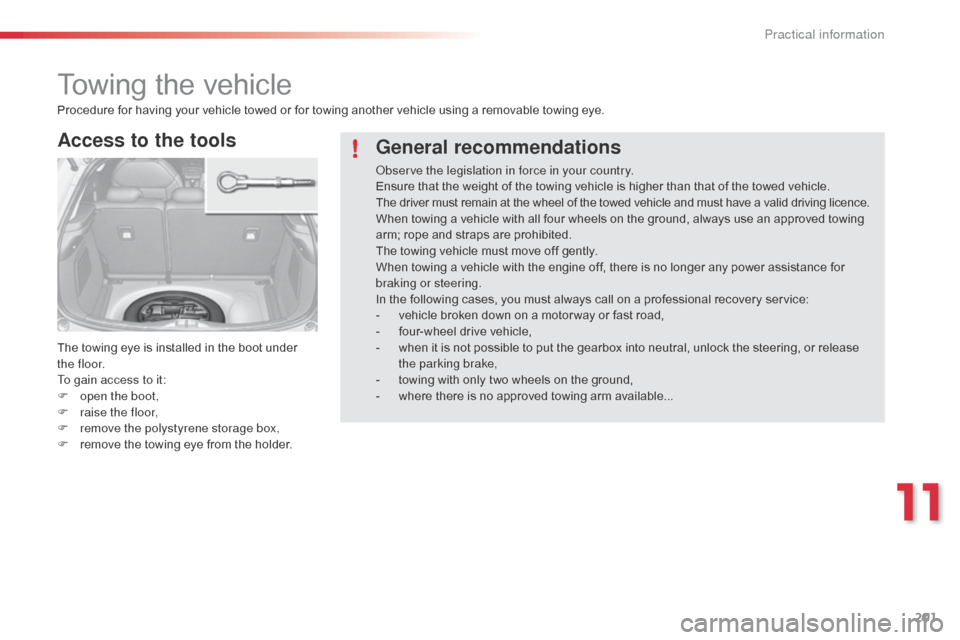
201
Towing the vehicle
Access to the tools
The towing eye is installed in the boot under
t h e f l o o r.
To gain access to it:
F
o
pen the boot,
F
r
aise the floor,
F
r
emove the polystyrene storage box,
F
r
emove the towing eye from the holder.
Procedure for having your vehicle towed or for towing another vehicle using a removable towing eye.
General recommendations
observe the legislation in force in your country.
Ensure that the weight of the towing vehicle is higher than that of the towed vehicle.
The driver must remain at the wheel of the towed vehicle and must have a valid driving licence.
When towing a vehicle with all four wheels on the ground, always use an approved towing
arm; rope and straps are prohibited.
The towing vehicle must move off gently.
When towing a vehicle with the engine off, there is no longer any power assistance for
braking or steering.
In the following cases, you must always call on a professional recovery service:
-
v
ehicle broken down on a motor way or fast road,
-
f
our-wheel drive vehicle,
-
w
hen it is not possible to put the gearbox into neutral, unlock the steering, or release
the parking brake,
-
t
owing with only two wheels on the ground,
-
w
here there is no approved towing arm available...
11
Practical information
Page 204 of 324
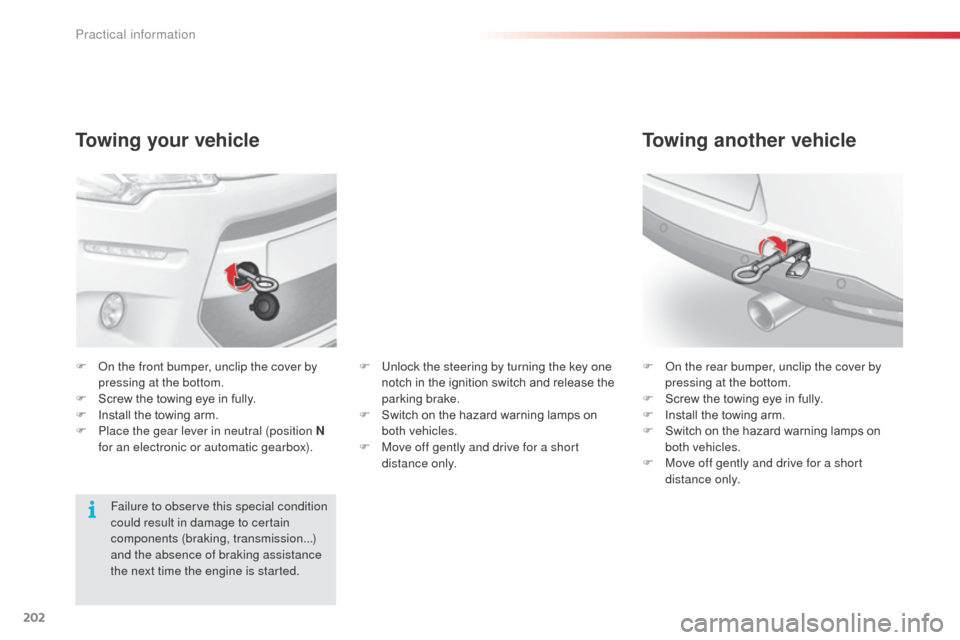
202
Towing your vehicle
F on the front bumper, unclip the cover by pressing at the bottom.
F
S
crew the towing eye in fully.
F
I
nstall the towing arm.
F
P
lace the gear lever in neutral (position N
for an electronic or automatic gearbox). F
on t he rear bumper, unclip the cover by
pressing at the bottom.
F
S
crew the towing eye in fully.
F
I
nstall the towing arm.
F
S
witch on the hazard warning lamps on
both vehicles.
F
M
ove off gently and drive for a short
distance only.
Towing another vehicle
Failure to observe this special condition
could result in damage to certain
components (braking, transmission...)
and the absence of braking assistance
the next time the engine is started. F
U
nlock the steering by turning the key one
notch in the ignition switch and release the
parking brake.
F
S
witch on the hazard warning lamps on
both vehicles.
F
M
ove off gently and drive for a short
distance only.
Practical information
Page 205 of 324

203
Towing a trailer
Distribution of loads
F distribute the load in the trailer so that the heaviest items are as close as possible to
the axle and the nose weight approaches the
maximum permitted without exceeding it.
Air density decreases with altitude, thus
reducing engine performance.
a
b
ove
1
000 metres, the maximum towed load must
be reduced by 10
% for every 1 000 metres of
altitude.
Your vehicle is primarily designed for
transporting people and luggage, but it may
also be used for towing a trailer.
Refer to the "Technical data" section for details
of the weights and towed loads which apply to
your vehicle.
We recommend the use of genuine
CITROËN towbars and their harnesses
that have been tested and approved
from the design stage of your vehicle,
and that the fitting of the towbar is
entrusted to a CITR
oËn
dealer or a
qualified workshop.
If the towbar is not fitted by a
CITR
oËn
dealer, it must still be
fitted in accordance with the vehicle
manufacturer's instructions.
Driving advice
Driving with a trailer places greater demands
on the towing vehicle and the driver must take
particular care.
Side wind
F Take into account the increased sensitivity to side wind.
11
Practical information
Page 206 of 324
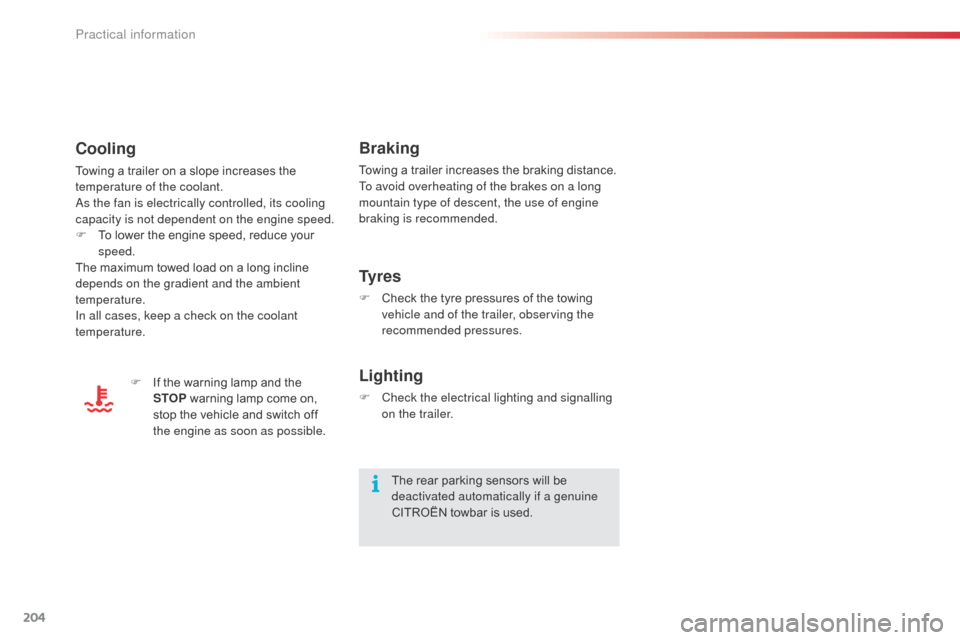
204
Braking
Towing a trailer increases the braking distance.
To avoid overheating of the brakes on a long
mountain type of descent, the use of engine
braking is recommended.
Ty r e s
F Check the tyre pressures of the towing vehicle and of the trailer, observing the
recommended pressures.
Lighting
F Check the electrical lighting and signalling on the trailer.
The rear parking sensors will be
deactivated automatically if a genuine
CITROËN towbar is used.
Cooling
Towing a trailer on a slope increases the
temperature of the coolant.
as t
he fan is electrically controlled, its cooling
capacity is not dependent on the engine speed.
F
T
o lower the engine speed, reduce your
speed.
The maximum towed load on a long incline
depends on the gradient and the ambient
temperature.
In all cases, keep a check on the coolant
temperature.
F
I
f the warning lamp and the
STOP warning lamp come on,
stop the vehicle and switch off
the engine as soon as possible.
Practical information
Page 207 of 324

205
EngineVTi 68PureTech 68 VTi 82PureTech 82
Gearbox Manual
(5-speed) Manual
(5 speed) Manual
(5-speed) ETG electronic
(5-speed) Manual
(5-speed)
Model code: SC... ZMZ0ZMZ 6 HMZ0HMZ0/P HMZ 6
Cubic capacity (cc) 999999 1 19 9 1 19 9
bo
re x stroke (mm) 71 x 84.171 x 84.1 75 x 90.5 75 x 90.5
Max power: EU standard (kW)* 5060 6060
Max power engine speed (rpm) 6 0006 000 5 7505 760
Max torque: EU standard (
nm
)9595 118 118
Max torque engine speed (rpm) 3 0003 000 2 7502 750
Fuel Unleaded UnleadedUnleadedUnleaded
Catalytic converter Ye sYe s Ye sYe s
Engine oil capacity (in litres)
with filter replacement 3.25
3.25 3.253.25
Petrol engines and gearboxes
* The maximum power corresponds to the value type approved on a test bed, under conditions defined by European legislation
(d irective 1999/99/EC).
.../S: model fitted with Stop & Start.
12
Technical data
Page 208 of 324

206
* The maximum power corresponds to the value type approved on a test bed, under conditions defined by European legislation (d irective 1999/99/EC).
Petrol engines and gearboxes
Engine PureTech 82
S&S VTi 95PureTech 110
S&S V Ti 120
Gearbox ETG electronic
(5-speed) ETG electronic
(5-speed) Manual
(5-speed) Manual
(5-speed)
a
utomatic
(4-speed)
Model code: SC... HMZ 6 / PS8FP0/PH
nZ 6 / S 5
FS05FS9
Cubic capacity (cc) 1 19 91 397 1 19 9 1 598
bo
re x stroke (mm) 75 x 90.577 x 7575 x 90.5 77 x 85.8
Max power: EU standard (kW)* 607081 88
Max power engine speed (rpm) 5 7606 000 5 500 6 000
Max torque: EU standard (
nm
)11813 6 205 160
Max torque engine speed (rpm) 2 7504 000 1 500 4 250
Fuel Unleaded Unleaded Unleaded Unleaded
Catalytic converter Ye sYe sYe s Ye s
Engine oil capacity (in litres) with filter
replacement 3.25
4.25 3.5 4.25
.../S: model fitted with Stop & Start.
Technical data
Page 209 of 324
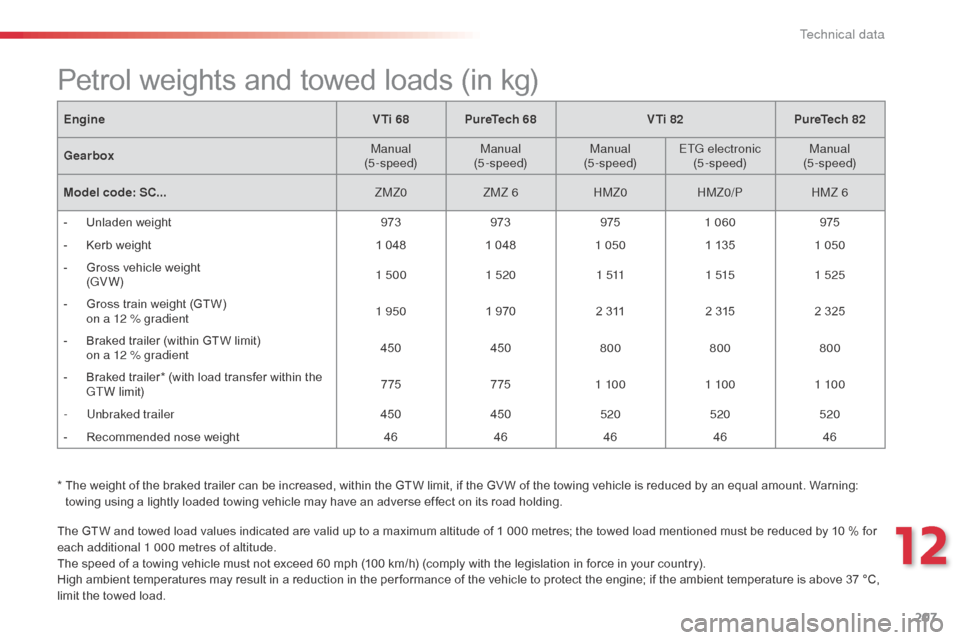
207
The GTW and towed load values indicated are valid up to a maximum altitude of 1 000 metres; the towed load mentioned must be reduced by 10 % for
each additional 1 000 metres of altitude.
The speed of a towing vehicle must not exceed 60 mph (100 km/h) (comply with the legislation in force in your country).
High ambient temperatures may result in a reduction in the per formance of the vehicle to protect the engine; if the ambient temperature is above 37 °C,
limit the towed load.
Petrol weights and towed loads (in kg)
EngineVTi 68PureTech 68 VTi 82PureTech 82
Gearbox Manual
(5-speed) Manual
(5-speed) Manual
(5-speed) ETG electronic
(5-speed) Manual
(5-speed)
Model code: SC... ZMZ0ZMZ 6 HMZ0HMZ0/P HMZ 6
-
U
nladen weight 973973 9751 060 975
-
K
erb weight 1 0481 048 1 050 1 1351 050
-
G
ross vehicle weight
(GV W) 1 500
1 520 1 5111 5151 525
-
G
ross train weight (GTW)
o
n a 12 % gradient 1 950
1 970 2 3112 3152 325
-
B
raked trailer (within GTW limit)
o
n a 12 % gradient 450
450800 800800
-
B
raked trailer* (with load transfer within the
GTW limit) 775
7751 10 0 1 10 01 10 0
-
U
nbraked trailer 450450 520520520
-
R
ecommended nose weight 4646464646
*
T
he weight of the braked trailer can be increased, within the GTW limit, if the GV W of the towing vehicle is reduced by an equal amount. Warning:
towing using a lightly loaded towing vehicle may have an adverse effect on its road holding.
12
Technical data
Page 210 of 324
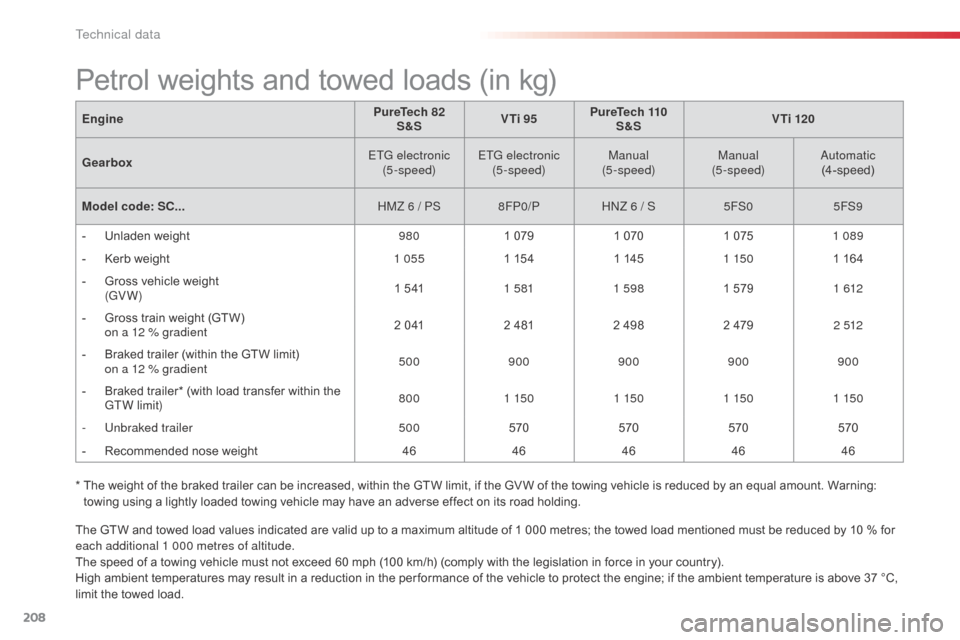
208
The GTW and towed load values indicated are valid up to a maximum altitude of 1 000 metres; the towed load mentioned must be reduced by 10 % for
each additional 1 000 metres of altitude.
The speed of a towing vehicle must not exceed 60 mph (100 km/h) (comply with the legislation in force in your country).
High ambient temperatures may result in a reduction in the per formance of the vehicle to protect the engine; if the ambient temperature is above 37 °C,
limit the towed load.
Petrol weights and towed loads (in kg)
EnginePureTech 82
S&S VTi 95PureTech 110
S&S V Ti 120
Gearbox ETG electronic
(5-speed) ETG electronic
(5-speed) Manual
(5-speed) Manual
(5-speed)
a
utomatic
(4-speed)
Model code: SC... HMZ 6 / PS8FP0/PH
nZ 6 / S 5
FS05FS9
-
U
nladen weight 9801 079 1 0701 0751 089
-
K
erb weight 1 0551 1541 1451 1501 164
-
G
ross vehicle weight
(GV W) 1 541
1 5811 598 1 579 1 612
-
G
ross train weight (GTW)
o
n a 12 % gradient 2 041
2 4812 498 2 4792 512
-
B
raked trailer (within the GTW limit)
o
n a 12 % gradient 500
900 900900900
-
B
raked trailer* (with load transfer within the
GTW limit) 800
1 150 1 1501 1501 150
-
U
nbraked trailer 500570570570570
-
R
ecommended nose weight 4646464646
*
T
he weight of the braked trailer can be increased, within the GTW limit, if the GV W of the towing vehicle is reduced by an equal amount. Warning:
towing using a lightly loaded towing vehicle may have an adverse effect on its road holding.
Technical data